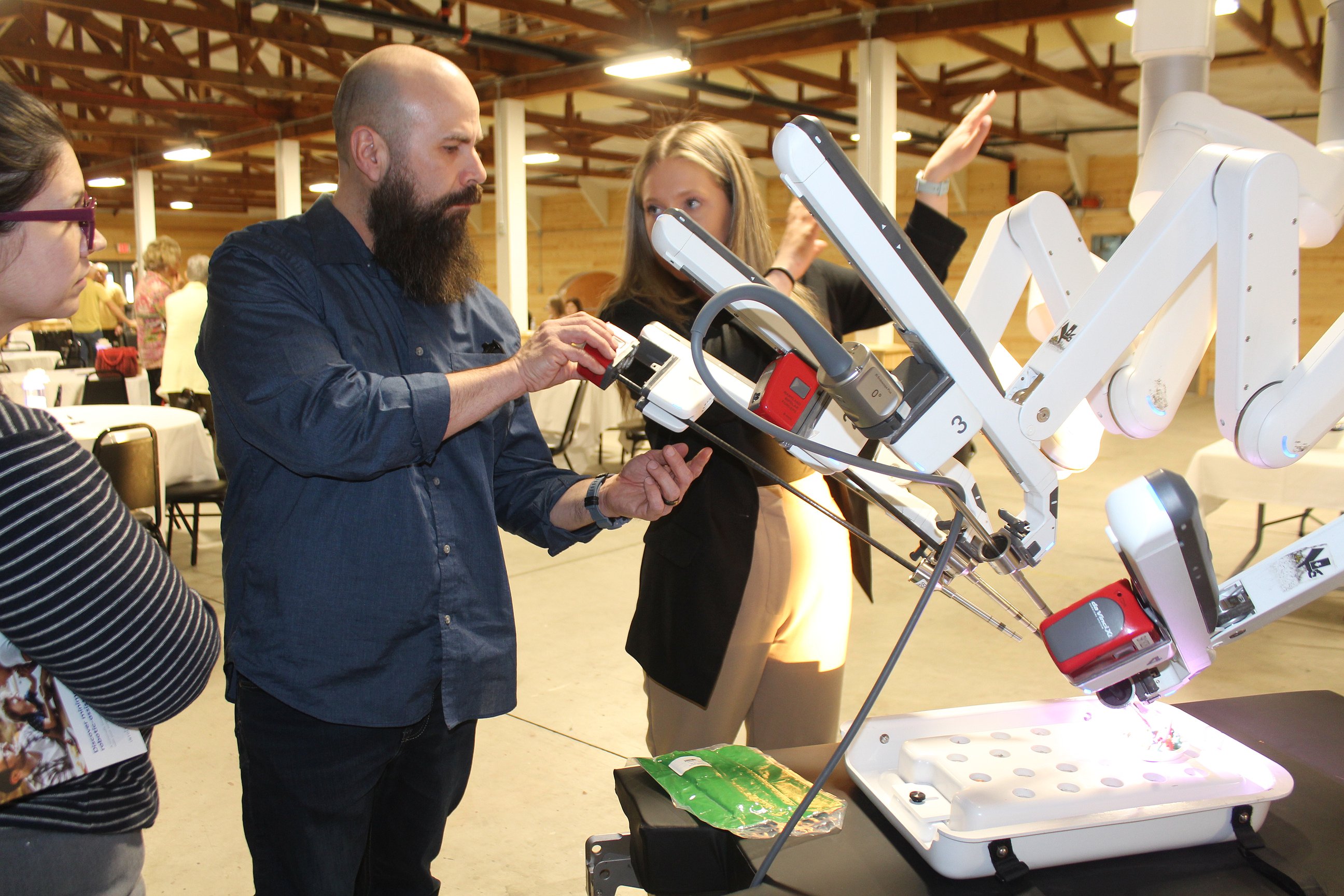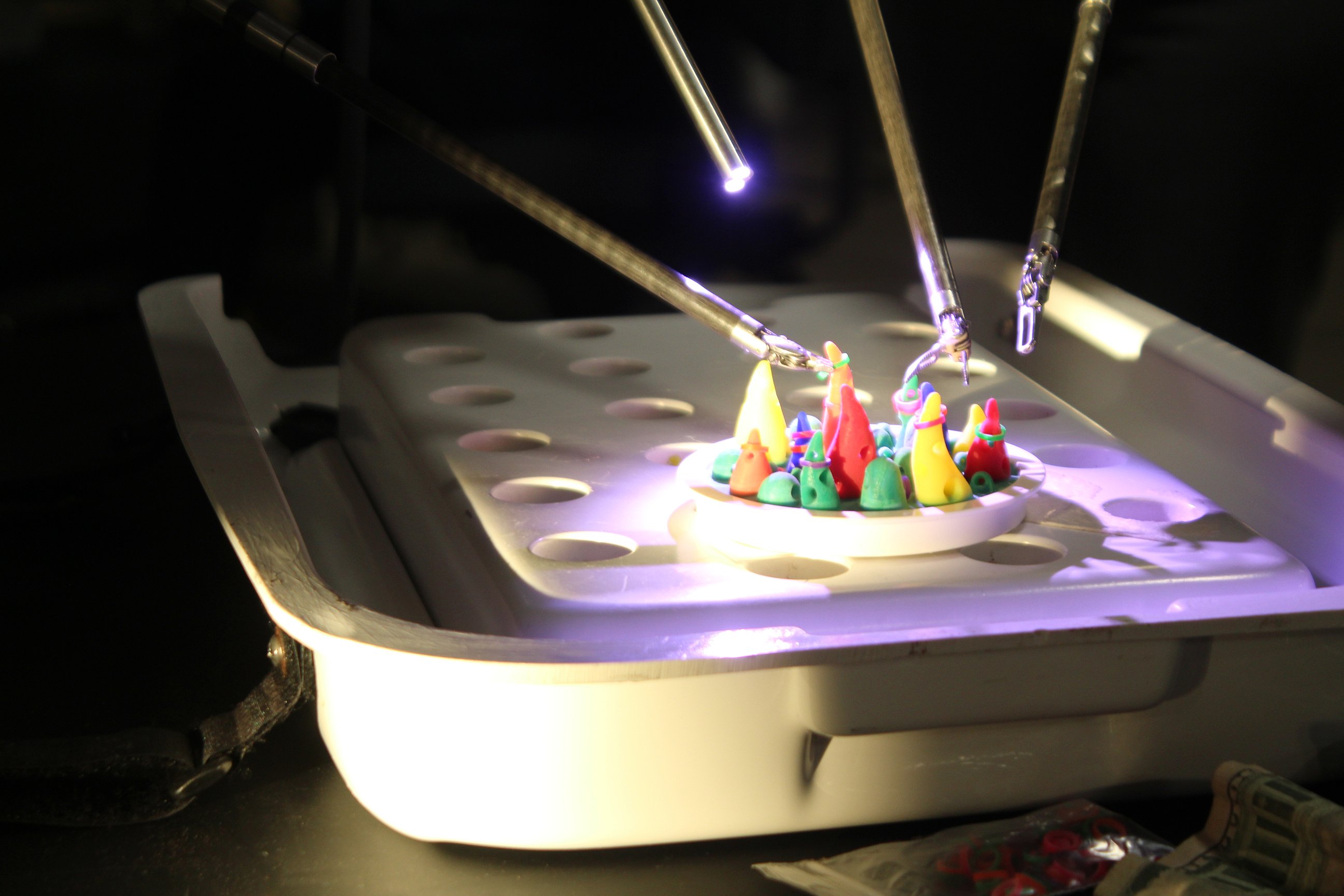Non-surgeons try out surgical robot at Samaritan demonstration
CHERYL SCHWEIZER | Hagadone News Network | UPDATED 10 months AGO
Senior Reporter Cheryl Schweizer is a journalist with more than 30 years of experience serving small communities in the Pacific Northwest. She began her post-high-school education at Treasure Valley Community College and enerned her journalism degree at Oregon State University. After working for multiple publications, she has settled down at the Columbia Basin Herald and has been a staple of the newsroom for more than a decade. Schweizer’s dedication to her communities and profession has earned her the nickname “The Baroness of Bylines.” She covers a variety of beats including health, business and various municipalities. | March 20, 2024 1:20 AM
MOSES LAKE — The brightly colored little cones were a little bigger than chocolate kisses. Under magnification from the demonstration da Vinci surgical robot, they looked more the size of cupcakes.
The demonstration robot was on display Monday during a presentation by Samaritan Healthcare surgeons and administrators. Samaritan purchased a model of the robot in late 2023 and put it into service in November. Cost was about $4 million, some of which was paid for with a federal grant, said Gretchen Youngren, Samaritan development and communications director, in an earlier interview.
Samaritan general surgeon Andrea Mattson said the robotic technology makes surgery easier for both the physicians and the patients.
“We’re controlling everything more than we ever could,” she said. “Because the precision — it’s so unmatched by any other technology.”
The robot is used for abdominal surgery. Mattson and fellow general surgeon Jordan Smith have been trained in its use, along with OB/GYN physicians Ryan Rasmussen and Kameron Firouzi.
During Monday’s presentation, Smith pointed to the multi-armed robot.
“If any of you look at that, you see how many arms there are on that? I was not built with that many arms,” he said. “I have one arm that’s retracting, and two arms that are operating. So in essence is being better than you ever were, because I couldn’t do that.”
The demonstration robot was just that — people could sit down at the surgeon’s console and try it out for themselves.
The console looks a little bit like a sizable 1980s-vintage computer, one with what looks like a television screen in its innards. That’s the screen the surgeon watches. The cameras provide magnification up to about 10 times actual size, Matson said.
The actual controls are underneath the console, and are a couple of control rods that are loosely strapped to the fingers and thumb.
The demo robot put people through an exercise, taking rings on and off the brightly colored tiny little cones. For people with a dominant hand, it proved surprisingly easy to use the non-dominant hand to move things around.
“It’s so much easier than I would’ve thought,” said Patti Paris, Moses Lake.
“That’s so cool. It’s almost like a video game,” said Kyrk Taylor, also of Moses Lake.
The robotic equivalent of a hand can move 360 degrees, Matson said, and is better able to fit into tight spaces. It’s easy to change the instruments, which slide in and lock into place.
Firouzi was among the speakers, and said among the advantages he has seen for patients are faster recovery and less pain after surgery. Surgeons have more options when it comes to performing a procedure, he said; he cited performing a hysterectomy as an example. That helps lessen both pain after the operation and recovery time, he said.
In answer to a question, Mattson said most surgeons are getting training in robotic techniques as part of their medical education.
“It would be atypical for them not to be recognized as the standard of care,” she said.
The surgeons at Samaritan have already received training in additional techniques, she said, which is a lengthy and rigorous process. Surgeons start with a video program that mimics the procedure.
“They’re training us in our proficiency. The little video games that they’re having us do — they’re measuring our range of motion, how many have we changed our hands around and everything,” she said. “And then they’re having us work on actual models.”
Once a surgeon has completed the training, he or she is assigned a proctor, a physician more experienced in the techniques who provides supervision and support, she said.
Cheryl Schweizer can be reached via email at cschweizer@columbiabasinherald.com.
MORE FRONT-PAGE-SLIDER STORIES
ARTICLES BY CHERYL SCHWEIZER

Upgrades to water system will be expensive, Moses Lake officials say
MOSES LAKE — Meeting the demands growth will make on Moses Lake’s water system will require updating some of the city’s development plana, and some discussion about how the Moses Lake City Council wants to handle growth. City Engineer Richard Law reviewed the city’s current planning process and consideration of future growth with council members Tuesday.

Othello board begins discussing next EP&O levy, a year early
OTHELLO — It’s a year away, but Othello School District officials are discussing the district’s next educational programs and operations levy.

Moses Lake council continues city manager search
MOSES LAKE — The Moses Lake City Council will meet in executive session Wednesday to discuss the qualifications of a possible candidate for city employment, according to an agenda posted on the city’s website Monday. A vote on a city manager contract is also on the agenda.










